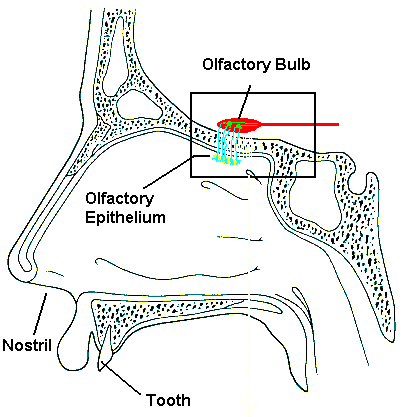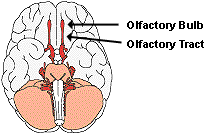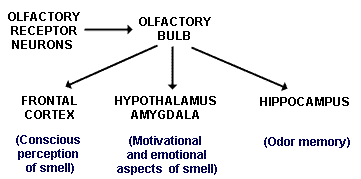| 4.
Odors map onto specific brain
areas
Because sight, sound, and touch sensations map in a spatial way onto brain
areas, researchers wondered if this happens with odors. They have found
that in the olfactory bulb, neurons, their cytoplasmic processes, and
support cells are not evenly distributed but form clumps called glomeruli.
Certain odorants activate only one or a small number of glomeruli,
producing a kind of mapping, although it is not a spatial map of the
location of odors in relation to the body, but a functional map of odor
types. Whether this mapping is continued at higher brain levels is
uncertain. A type of spatial mapping also exists in the olfactory
epithelium, in the nasal passages. Here, scientists have shown that
certain
volatile chemicals attach to receptor cells in defined patches of
epithelium and not to others.
5. Patterns of neural activity allow
us to identify odors
To summarize the process of odor detection, let's follow an odorant into
the nose. At 7 a.m., molecules from a cup of coffee float into the air
and drift into your nose. You breathe deeply, drawing the molecules up
into the top of your nasal passages. Several types of molecules are
present, and each fits into a slot on a membrane receptor that can
accommodate only that class of molecular structures.
As soon as the molecules stick to their receptors, intracellular systems
of enzymes and substrates go into gear, quickly causing each cell to
produce an electrical signal. The signal flashes through the axon of each
olfactory sensory neuron and on to cells in the olfactory bulb. Each type
of receptor neuron sends its signal to a specific clump of cells in the
olfactory bulb, forming a sort of odor map.
From here, the message from each bulb cell zips to several places by way
of branches from the cell's axon. Messages to the olfactory cortex give
you that "aahhh" feeling, others activate memories of previous cups of
coffee, still others wind up stimulating motor areas to cause
salivation. The signals travel another pathway to your frontal cortex,
which "says" to you: "COFFEE!"
The experiences of perceiving and interpreting the coffee odor are the
result of activating a pattern of neural components, and
in turn, specific
memories, feelings, and thoughts.
6. Several mechanisms
may contribute to olfactory fatigue
Adaptation, or fatigue, to constant stimulation is a
general feature of
sensory systems. For instance, the touch receptor cells in the skin adapt
to the stimulation of our clothes, a fortunate thing, or we would be
distracted by them constantly. Adaptation involves mechanisms at the
level of the receptor cell, including the inactivation of ion channels in
the membrane that generate the electrical signal. In a simplified
explanation, after a stimulus causes a receptor cell to produce an
electrical signal, the cell membrane soon stops allowing ions to flow,
thus preventing further signals. Removal of the stimulus followed by
restimulation activates the process all over again.
Researchers have noted that people adapt to odors, such as the smell of
tobacco smoke in a room, more quickly than the properties of olfactory
receptor cells would predict. Thus, they believe that olfactory fatigue
involves some types of central nervous system mechanisms as well as
receptor adaptation. Although these brain mechanisms are currently
unknown, scientists speculate that inhibitory circuits in the brain
"quash" the incoming sensory signals from receptors before they reach
conscious levels.
7. Genes determine the
kinds of odor receptors that we have, and
experiences shape our perceptions
Olfactory abilities vary widely among individuals -- we all know someone
who
is able to smell things when no one else can, or someone who doesn't seem
to mind an unpleasant odor when most people do. Studies have shown that
people who are unable to smell one or one class of odors frequently have
small genetic differences from the general population. The inability to
smell is called "anosmia," and it may be general, or specific for one
odor. Temporary general anosmia or "hyposmia" (lessened sense of smell)
can result from a cold or certain medicines. "Hyperosmia," a heightened
sense of smell, can be a genetic trait.
Previous experiences and our physiological states also affect our
reactions to odors and our perceptions. The odor of frying trout or hot
cocoa may smell wonderful to a hungry camper, but terrible to someone with
the stomach flu. A child who remembers her mother sprinkling cinnamon on
her little brother's vomit before cleaning it up may never want cinnamon
cookies again, even as an adult.
Our expectations and beliefs can even affect measurements such as
olfactory fatigue times. Studies have shown that the time for adapting to
an odor is significantly different when people believe they
are being exposed to a harmless aroma, compared to when they think they
are smelling a hazardous substance, even when the odor is exactly the
same.
8. Olfactory disorders
may be genetic, or may result from illness or
injury
While genetic differences account for some cases of anosmia or other
olfactory disorders as mentioned above, most are caused by illnesses or
accidents. Small growths in the nasal cavities (polyps), dental problems,
hormonal disturbances, or sinus infections, as well as common colds, may
cause chemosensory losses. Injury to the head may damage nerve fibers or
break axons. Patients who receive radiation therapy for cancers of the
head or neck often develop changes in their sense of smell.
Are these disorders serious? Our sense of smell alerts us to fires,
poisonous fumes, leaking gas, and spoiled food. It can stop us from
entering a dangerous area or putting something into our mouths that can
make us sick. Further, such disturbances can be a signal that some other
disease is present, such as Parkinson's disease, hypertension, or
diabetes. People should see a doctor if they realize something is wrong
with their sense of smell.
| 





 Where do odor
messages go once they activate the sensory neurons in the nasal cavity?
To get to the brain, the axons of the olfactory sensory neurons must get
through the skull (see side view of the skull in Figure 1 on the
left).
Where do odor
messages go once they activate the sensory neurons in the nasal cavity?
To get to the brain, the axons of the olfactory sensory neurons must get
through the skull (see side view of the skull in Figure 1 on the
left). The olfactory epithelium lines the bone of the part of the skull just
above the nasal passages, and the axons of the neurons pass directly
through tiny holes in this bone. Here they enter the first relay station,
the olfactory bulbs, one on either side of the bottom surface of the brain
(Figure 2, right). The electrical signal generated when an olfactory
sensory neuron is activated is passed along to a secondary neuron residing
in the bulb, and from here the signal goes by way of the olfactory tract
to other brain areas.
The olfactory epithelium lines the bone of the part of the skull just
above the nasal passages, and the axons of the neurons pass directly
through tiny holes in this bone. Here they enter the first relay station,
the olfactory bulbs, one on either side of the bottom surface of the brain
(Figure 2, right). The electrical signal generated when an olfactory
sensory neuron is activated is passed along to a secondary neuron residing
in the bulb, and from here the signal goes by way of the olfactory tract
to other brain areas. 
 [Back to Top]
[Back to Top]![[email]](./gif/menue.gif)

